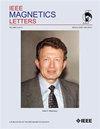Computing in Memory Using Doubled STT-MRAM With the Application of Binarized Neural Networks
IF 1.1
4区 物理与天体物理
Q4 ENGINEERING, ELECTRICAL & ELECTRONIC
引用次数: 0
Abstract
The computing-in-memory (CiM) approach is a promising option for addressing the processor–memory data transfer bottleneck while performing data-intensive applications. In this letter, we present a novel CiM architecture based on spin-transfer torque magnetic random-access memory, which can work in computing and memory modes. In this letter, two spintronic devices are considered per cell to store the main data and its complement to address the reliability concerns during the read operation, which also provides a fascinating ability for performing reliable Boolean operations (all basic functions), binary/ternary content-addressable memory search operation, and multi-input majority function. Since the developed architecture can perform bitwise双STT-MRAM在存储器中的计算及二值化神经网络的应用
内存计算(CiM)方法是一种很有前途的选择,可以在执行数据密集型应用程序时解决处理器-内存数据传输瓶颈。在这封信中,我们提出了一种基于自旋转移力矩磁随机存取存储器的新型CiM架构,该架构可以在计算和存储模式下工作。在这封信中,每个单元考虑两个自旋电子器件来存储主数据及其补码,以解决读取操作期间的可靠性问题,这也为执行可靠的布尔运算(所有基本功能)、二进制/三进制内容可寻址存储器搜索操作和多输入多数功能提供了迷人的能力。由于所开发的架构可以在一个周期内执行逐位xnor运算,因此设计了一种基于电阻的累加器来执行多输入多数产生,以改进实现快速低成本二进制神经网络(BNN)的结构。为此,乘法、累加和通过激活函数在三个循环中完成。在BNN应用中利用该架构的仿真结果表明,功率延迟乘积比现有架构低86%–98%。
本文章由计算机程序翻译,如有差异,请以英文原文为准。
求助全文
约1分钟内获得全文
求助全文
来源期刊

IEEE Magnetics Letters
PHYSICS, APPLIED-
CiteScore
2.40
自引率
0.00%
发文量
37
期刊介绍:
IEEE Magnetics Letters is a peer-reviewed, archival journal covering the physics and engineering of magnetism, magnetic materials, applied magnetics, design and application of magnetic devices, bio-magnetics, magneto-electronics, and spin electronics. IEEE Magnetics Letters publishes short, scholarly articles of substantial current interest.
IEEE Magnetics Letters is a hybrid Open Access (OA) journal. For a fee, authors have the option making their articles freely available to all, including non-subscribers. OA articles are identified as Open Access.
 求助内容:
求助内容: 应助结果提醒方式:
应助结果提醒方式:


